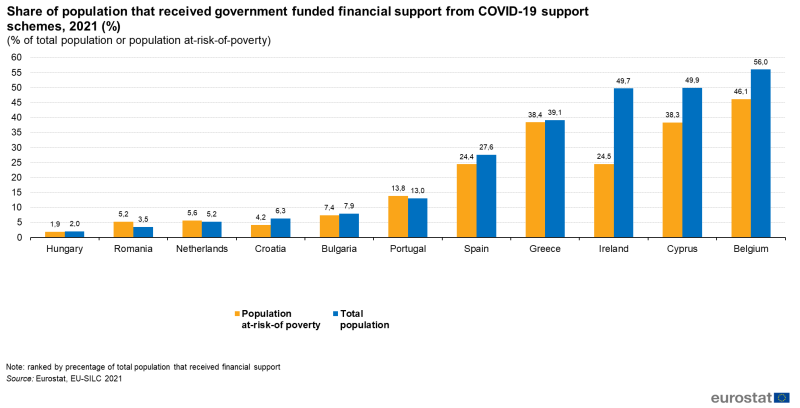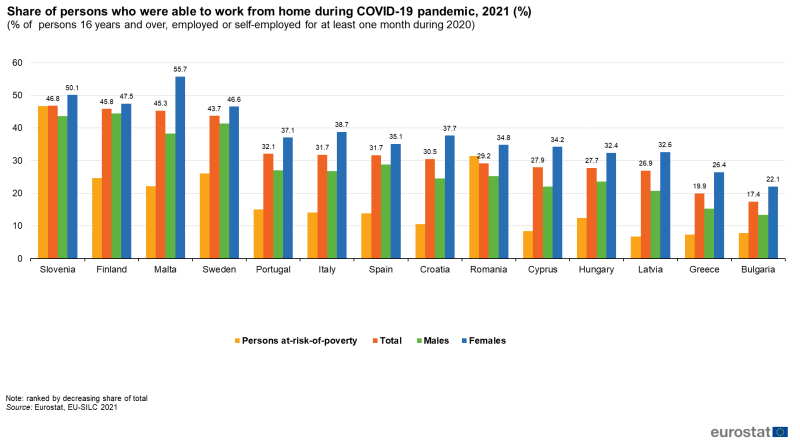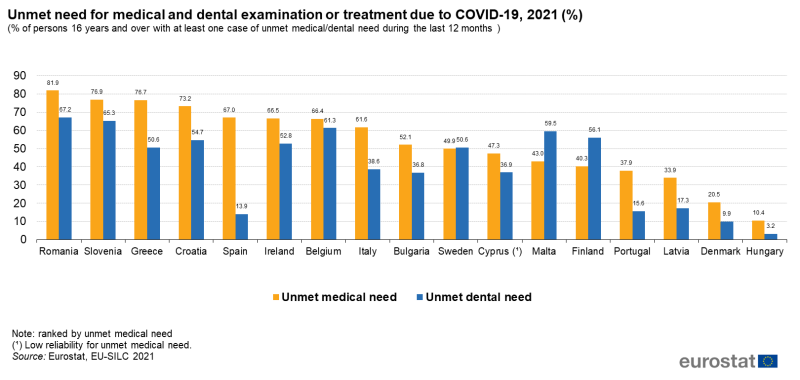Impact of COVID-19 on households
Data extracted in October 2022.
No planned article update.
Highlights
In 2021, 84.0 % of the EU population reported a stable or increased income compared with the previous year.
In 2021, children (5-15 years old) living in poor or overcrowded households had fewer opportunities for distance learning during COVID-19 restrictions than children not living in poor or overcrowded households.
In 2021, men were less able to work from home during COVID-19 restrictions than women.
In 2021, COVID-19 had a negative impact on mental health/well-being.
This article presents statistical data on the impact of COVID-19 on households collected through complementary variables that were included on a voluntary basis in the 2021 EU statistics on income and living conditions (EU-SILC). More specifically, the article focuses on the impact of COVID-19 on household income, education and working conditions, access to health services, as well as on mental health/well-being.
Full article
Key findings
84.0 % of the EU population lived in a household whose net income either remained stable (66.5 %) or increased (17.5 %) in 2021 compared with the previous year. In all EU Member States in 2021, more than half the population were living in a household with a more or less stable income during the last year.
The COVID-19 pandemic affected living conditions in the EU. In addition to changes in income, other changes were experienced in education and working conditions, the mental health/well-being of people and the general conditions under which health care systems operated. As a result:
- In the 14 Member States for which data are available, for people living in households with children 5-15 years old, at least three-quarters of the children were able to adequately follow their courses by distance learning. The share for people living in poor households, or overcrowded households, were lower than the share for the total population in 13 and 10 Member States, respectively.
- In 12 of the 14 Member States with data available, more than one-quarter of the employed (employees and self-employed) population aged 16 years and above were able to fully or partially work from home during the pandemic. The percentage of men able to telework was lower than that of women.
- In 10 of the 13 Member States with data available, more than half the population aged 16 years and above was negatively affected in terms of mental health/well-being during the COVID-19 pandemic. The percentage of women negatively affected was higher than that of men.
Evolution of household income
Majority of population have stable income
In 2021, 84.0 % of the EU population lived in a household whose net income either remained stable (66.5 %) or increased (17.5 %) compared with the previous year (Figure 1).
The percentage of the population living in a household with a stable income in 2021 compared with the previous year was above 50.0 % in all EU Member States[1], ranging from 50.7 % in Cyprus to 84.0% in Italy. Regarding the population that declared an increase in their household income, the share ranged from 4.9 % in Italy and 6.9 % in Greece to above 30.0 % in Sweden (32.3 %) and Czechia (34.8 %).
The percentage of the EU population living in households that reported a decrease in income compared with the previous year was 16.0 %. The share ranged from 5.4 % in Romania and 9.4 % in Belgium to 26.3 % in Greece and 27.6 % in Cyprus.
In 17 EU Member States, the percentage of the population that reported an increase in income was higher than the percentage of the population that reported a decrease, with the difference being more than 10 percentage points (pp) in 8 of these Member States. On the contrary, the percentage of the population with a decrease in income was higher than that with an increase in 9 EU Member States with the difference being below 10 pp in 8 of these Member States. The lowest and highest differences observed between increase and decrease in income, among the Member States, were 0.7 pp in Croatia and 21.6 pp in Romania, respectively (for both, the increase was higher than the decrease).
Government funded COVID-19 financial support was high in many EU Member States
Financial support from COVID-19 related support schemes, defined as payments made by governments for the benefit of households or household members, played an important role in relieving negative COVID-19 effects in some of the EU Member States. This support included different types of allowances for various reasons such as housing, unemployment, etc. Figure 2 presents COVID-19 related financial support for 11 EU Member States that collected this information.
In 2021, the share of the population that reported they lived in a household that received government funded financial support from COVID-19 related support schemes during the previous year, ranged from 2.0% in Hungary to 56.0% in Belgium.
Focusing on the population living in a household at-risk-of-poverty, the share of people who received financial support from COVID-19 related schemes ranged from 1.9 % in Hungary to 46.1 % in Belgium. When comparing the population that received financial support in the total population with those that received financial support in the population at-risk-of-poverty, the share was lower for the at-risk-of-poverty population in 8 of the 11 EU Member States that collected this data. Among these 8 EU Member States, the difference ranged from 0.1 pp in Hungary to above 10 pp in Cyprus (11.6 pp) and Ireland (25.2 pp).
Impact of COVID-19 on education and working conditions
The COVID-19 outbreak in 2020 and the restrictions imposed affected everyday living conditions. This part of the article presents the changes implemented during the pandemic on education and working conditions in relation to distance learning and the possibility of working from home (teleworking) in 14 EU Member States with available data.
Children (5-15 years old) living in poor or overcrowded households had fewer opportunities for distance learning (courses/school) than children not living in poor or overcrowded households
Table 1 shows the percentages of people living in households with at least one child (5-15 years old) attending school whose children were able to adequately attend their courses/school from home during the COVID-19 restrictions, in the 12 months preceding the interview.
As shown in Table 1, in 14 EU Member States, for at least three-quarters of the population living in households with children 5-15 years, the children were able to follow their courses by distance learning. The percentages ranged from 74.7 % in Hungary to 98.6 % in Latvia. The respective percentages for the reference population living in poor households were lower than those for the total reference population in 13 of the 14 EU Member States, with the exception of Sweden[2]. The difference ranged from -0.9 pp in Croatia to above 20 pp in Hungary (-20.5 pp) and Bulgaria (-22.0 pp). Furthermore, the respective percentages for the reference population living in overcrowded households were lower than those for the total reference population in 10 of the 14 EU Member States with the difference ranging from -0.4 pp in Latvia to -15.0 pp in Spain.
Regarding the shares of the population whose children could not adequately attend distance learning due to lack of internet connection or devices, these ranged from 0.0 % in Sweden to 9.3 % in Romania.
The percentages of those unable to attend distance learning due to lack of internet connection or devices, was higher for both sub-populations - living in poor and overcrowded households - than for the total reference population. More specifically, the share of those unable to attend distance learning due to lack of internet connection or devices, for the population living in poor households was higher than that of the total reference population in all EU Member States with the exception of Sweden (0.0 % lack of internet/devices). The respective share for the population living in overcrowded households was higher than that of the total reference population in 12 of the 14 EU Member States with the exception of Sweden (0.0 % lack of internet/devices) and Croatia (equal share).
When further examining the differences in shares of lack of internet/devices between the population living in poor households and the total reference population, these were higher than the respective differences in shares of lack of courses/other reasons in 11 of the 14 EU Member States and they ranged from 1.7 pp in Latvia to 15.8 pp in Romania. Additionally, the differences in shares of lack of internet/devices between the population living in overcrowded households and the total reference population, were higher than the respective shares of lack of courses/other reasons in 12 of the 14 EU Member States and they ranged from 0.5 pp in Latvia to 17.5 pp in Spain.
People living in poor households were less able to work from home during COVID-19 restrictions than the total in-work population aged 16 years and above
Figure 3 shows the ability to work from home during COVID-19 restrictions in 14 EU Member States that collected this information. The share of persons 16 years and above having a full or part-time job, who were able to fully or partially telework during COVID-19 restrictions, were over one quarter in 12 of the 14 EU Member States presented in Figure 3 and ranged from 17.4 % in Bulgaria to 46.8 % in Slovenia.
The possibility to telework during COVID-19 restrictions was lower for people living in poor households than for the total reference population in 13 of the 14 EU Member States with the exception of Romania. The difference in shares between people living in poor households and the total reference population was above 10 pp in all EU Member States except Slovenia (-0.1 pp) and Bulgaria (-9.7 pp) reaching a peak in Malta with a difference of - 23.1 pp.
Men were less able to work from home during COVID-19 restrictions than women
In Figure 3, the share of people able to telework is also presented for men and women separately. As indicated in the graph, the share of women able to telework during COVID-19 restrictions was higher compared with that of men in all of the 14 EU Member States with available data. The difference ranged from +3.0 pp for women in Finland to +17.4 pp in Malta and it was at least 10 pp in 7 out of the 14 EU Member States.
Impact of COVID-19 on access to health services and mental health/well-being
This part of the article provides some insight on the accessibility to health care services during the COVID-19 restrictions as well as on the impact the pandemic had on people’s mental health/well-being.
High shares of unmet medical and dental needs due to COVID-19
One way to assess the impact of COVID-19 on access to health care services and operation of health care systems is to examine if the unmet medical needs during the pandemic were a result of the restrictions imposed, and the further implications this might have. The share of unmet medical and dental examinations or treatment due to COVID-19 during the 12 months preceding the interview are presented for 17 EU Member States that collected these data.
As shown in Figure 4, COVID-19 was the reason behind the unmet medical needs or treatment for more than half of the persons 16 years and above in 9 of the 17 EU Member States presented. The share of the population with unmet medical needs due to COVID-19 as part of the total unmet needs ranged from 10.4 % in Hungary and 20.5 % in Denmark to above three-quarters in Greece (76.7 %), Slovenia (76.9 %) and Romania (81.9 %).
Regarding unmet dental needs or treatment due to COVID-19, the share was lower compared with that for unmet medical needs in 14 of the 17 EU Member States. It ranged from 3.2 % in Hungary and 9.9 % in Denmark to more than 60.0 % of total unmet dental needs in Belgium (61.3 %), Slovenia (65.3 %) and Romania (67.2 %). As for unmet medical needs, in 9 of the 17 Member States, for more than half of the persons 16 years and above, unmet dental needs was a result of the COVID-19 restrictions.
COVID-19 had a negative impact on mental health/well-being
People's mental health/well-being has been negatively affected by COVID-19 as shown in Figure 5 that presents data for 13 EU Member States based on respondents' self-assessment. According to Figure 5, more than half of the population aged 16 years and above was negatively affected in terms of mental health/well-being due to COVID-19 in 10 of the 13 EU Member States. The shares ranged from 26.6 % in Portugal and 43.4 % in Slovenia to more than 70.0 % in Bulgaria (70.1 %) and Greece (74.9 %). When focusing on the population living in poor households, the shares ranged from 29.6 % in Portugal and 44.4 % in Slovenia to 76.9 % in Greece. The shares for people living in poor households were higher than those for the total reference population in 8 out of the 13 EU Member States with differences ranging from 0.2 pp in Spain to 6.3 pp in Croatia.
COVID-19 negative impact on mental health/well-being was higher for women than for men
As shown in Figure 5, the share of negative impact on mental health/well-being of COVID-19 was higher for women than for men in all the 13 EU Member States. More analytically, shares for women ranged from 30.2 % in Portugal to 76.6 % in Greece while in 11 of the 13 Member States more than half of the women 16 years and above were negatively affected by COVID-19.
The share for men ranged from 22.4 % in Portugal to 73.1 % in Greece while more than half of men aged 16 years and above were negatively affected in 6 of the 13 EU Member States. The difference between women and men ranged from +3.5 pp in Greece to above 10 pp in Romania (11.3 pp) and Sweden (13.5 pp).
Source data for tables and graphs
Data sources
The data used in this article are derived from a few complementary variables included on a voluntary basis in EU-SILC in 2021 in order to measure the impact of COVID-19 on households. The number of countries that collected the additional information differs per variable and ranges from 11 to 17. The analysis is supplemented with the results on change in household income compared with the previous year that was collected at EU level.
Context
The optional variables presented in this article aimed at measuring the impact of COVID-19 on household income, education and working conditions, access to health services and individuals mental health/well-being. In this context the following optional information was collected:
- Financial support from COVID-19 related support schemes: it included different types of allowances for various reasons in the categories of a) support to households b) support for employees c) support for the self-employed and d) any other COVID -19 related financial assistance.
- Possibility for children 5-15 years old attending school to properly follow their courses by distance learning: if in a given household at least one child did not have the possibility to properly attend their courses – inadequate internet connection or computer/mobile device when necessary – then it was assumed that all the children in that household had limitations in accessing their lessons online for the specific reason.
- Ability to work from home during COVID-19 restrictions: it was collected for persons 16 years old and over, declaring at least one month working (full or part time) during the previous year (2020).
- Unmet need for medical/dental examination or treatment due to COVID-19: it was examined if the reason behind the unmet health needs was COVID-19.
- Mental health: according to WHO mental health is a state of well-being in which an individual can realise his/her own potential, cope with normal stresses of life, work productively and make a contribution to the community. Concepts of mental health include subjective well-being, perceived self-efficacy, autonomy, competence, and self-actualisation of one's intellectual and emotional potential. Other dimensions include self-acceptance, personal growth, positive relations with others, a sense that one's life has purpose and meaning, the ability to control one's own life etc.
Direct access to
Dedicated section
Publications
Methodology
- Income and living conditions (ESMS metadata file — ilc_esms)
- Income and living conditions — information on data
- Income and living conditions — methodology
Legislation
- Detailed list of legislative information on EU-SILC provisions for survey design, survey characteristics, data transmission and ad-hoc modules
- Regulation (EC) No 2019/1700 — the central piece of legislation for social surveys including EU-SILC
- Regulation (EC) No 2019/2242 — additional central piece of legislation for EU-SILC
- Summaries of EU Legislation: EU statistics on income and living conditions
External links
- European Commission — Directorate-General for Employment, Social Affairs & Inclusion — Employment and Social Developments in Europe 2021
- European Commission — Directorate General for Employment, Social Affairs & Inclusion — Indicators' Sub-Group of the Social Protection Committee
- European pillar of social rights
Notes





